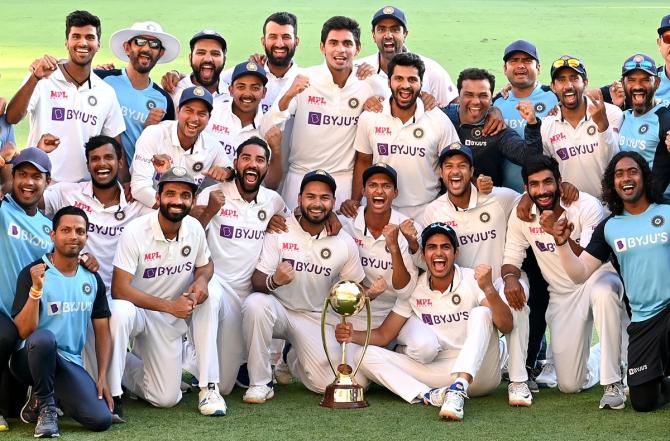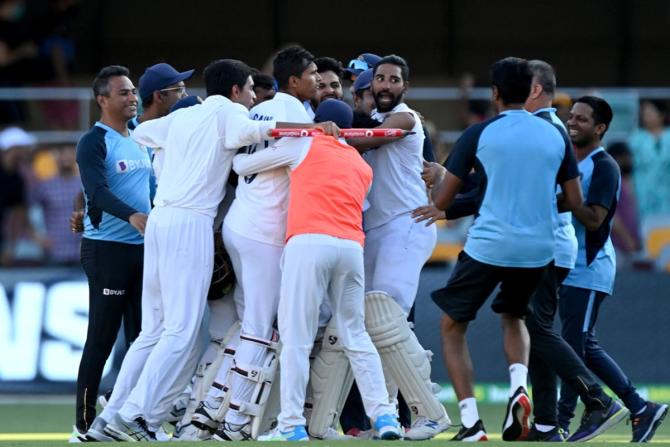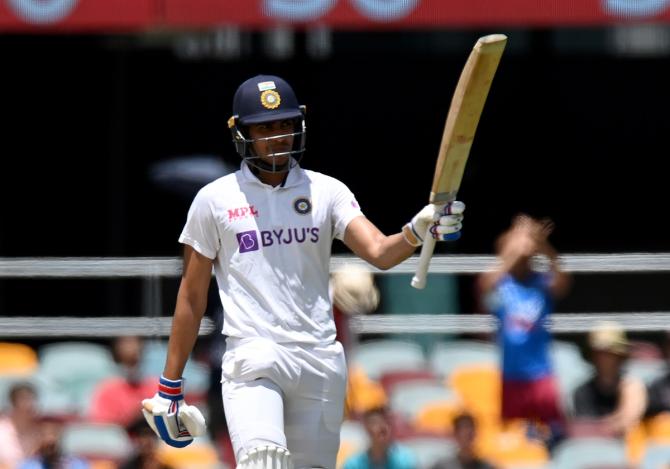 | « Back to article | Print this article |
What happened at the Gabba on January 19, 2021 now sits at the pinnacle of India's most significant Test wins, declares Faisal Shariff.

Pacing around the Chidambaram stadium under an unforgiving Chennai sun, I was unable to handle the pressure. From 101 for two, India was 122 for five.
I was witnessing 'The once in a lifetime' moment -- an implausible Indian win.
The year was 2001. India were 20 odd runs from a historic series win against Steve Waugh's Invincibles chasing the Final Frontier.
A blinder from Mark Waugh saw V V S Laxman return to the pavilion. Until then, Laxman was carrying on from that phenomenal 281 he scored at the Eden Gardens a few days earlier with sublime fluency.
That pressure. That incredible chase. With just two wickets in hand, Harbhajan Singh -- deservingly -- scored the winning runs. India won 2-1 against one of the greatest cricket teams ever.
A peep into the Australian dressing room that day, the scene resembled the camp of a vanquished army -- bats, pads, and other cricketing paraphernalia strewn everywhere, like arms abandoned by a vanquished army.
In the middle of that mess sat Steve Waugh wearing his Baggy Green staring at defeat, musing on what could have been, as he sipped a soda.
I considered myself privileged to have seen cricketing history scripted up close.

Twenty years later, watching a bunch of young but determined cricketers walk around the Gabba with the Indian flag having smashed 324 runs on the last day and handing the Aussies their first-ever defeat on a ground unconquered since 1988, I rephrase now -- I had not seen it all.
What happened at the Gabba on January 19, 2021 now sits at the pinnacle of India's most significant Test wins.
Consider this about the team that lifted the silverware today: Bowled out for their lowest Test total in 88 years, see their superstar captain Virat Kohli leave the team for the delivery of his first child, lose critical players to injuries, a coach who isn't the greatest of strategists and probably past his use-by date and up against easily the best bowling attack in the world smacking their lips at the opportunity to hurt with the red cherry.
Exactly a month later, under the leadership of the 'Bombay Buddha' Ajinkya Rahane, who warmed the benches in the money-spinning IPL tournament for two months, India retained the Border-Gavaskar Trophy 2-1.
There was no superstar Kohli. There was no Ishant. No Shami. No K L Rahul. And yet, in true Rudyard Kipling's inspiring style, each wolf became the strength of the pack.
But the Indian team won the series in their head when Rahane scored a 100 on Boxing Day at Melbourne to level 1-1.
Australia lost the series when Hanuma Vihari and Ashwin defied them to draw the Test at Sydney for an entire day.
The Gabba was just the culmination of that belief.

Imagine a batting line-up comprising the following names:
· Rahul Dravid
· Sourav Ganguly
· Sachin Tendulkar
· V V S Laxman
· Yuvraj Singh
· Mahendra Singh Dhoni
This line-up could not bat out a single day in the 2008 Sydney Test against an understrength Aussie attack still reeling from Shane Warne and Glenn McGrath's retirements.
Australia had a new bowling attack, and India had a dream batting line-up. Yet it fell short.
The golden generation was at the fag end of a glorious run, but more was expected from them in Sydney.
The racism allegations against Harbhajan Singh had vitiated the atmosphere.
Mark Benson and Steve Bucknor's umpiring was atrocious; the Aussies refused to walk even after nicking to slip.
Despite all this, the Indian team could not find the steel to battle out on that final day.
Contrast that to the performance 13 years later by another generation of Indian batsmen, and you want to see the makers sign on their steel.
What made the performance even more creditable was that unlike the 2008 Aussie attack, the bowling in 2021 is undoubtedly the best of this generation.
It is the best all-round attack in world cricket today, yet a bunch of greenhorns managed to do what fancied champions could not do in 2008.
The credit for this obviously lies at the door of the Zen from Mumbai, Captain Ajinkya Rahane.
Suddenly the rise of a soldier from the ranks to the general position seems to have steeled an entire squad.
Suddenly characters who were usually diffident and unwilling to express themselves under the shadow of the superstar Captain Kohli were ready to stand up to the Aussie bullies.
Everyone in this team believed. Everyone in this team was breathing. Contributing what their broken bodies could offer.
What Rahane has provided with his leadership has been calm, decisiveness and empowerment.
His leadership style has given a voice to every member of the team and hence you see that sense of ownership, that nimbleness of a start-up, not the inflexibility of a huge multinational.
Like a scrum master, Rahane empowered the bowling unit, the middle order, the all-rounders to take ownership of their roles and execute.
He never bothered being the project manager, merely the scrum master who enabled processes within the team.
Hopefully, therein lies a clue to have an agile leader rather than a superstar who overshadows the team.

Rahane took over the team's reins with a handicap since he didn't have the luxury of choosing the playing eleven but making do with those still standing to fight for 450 overs spread across five days. And fight they did.
Take Hanuma Vihari as a shining example. He made a huge statement literally batting on one leg.
A torn hamstring didn't weaken his desire to block out the Aussie onslaught. Along with Ashwin, he worked out the strategy that Australia failed to read.
Ashwin took on Nathan Lyon so that a hamstrung Vihari did not have to press forward while batting.
At the other end, Vihari was prepared to take on the short ball to give Ashwin's stiff back some respite.
All this while Australia's Captain Tim Paine was busy dropping verbals and catches around the batting crease to break the partnership. If only he'd used his mouth to command Lyon to change ends.
The sheer audacity in Shubman Gill and Rishabh Pant's stroke-play marks them out as the sweet spot of this Indian batting line up.
The all-round skills and composure of Shardul Thakur and Washington Sundar gave the team the balance and options last seen when Irfan Pathan was at the top of his game.
And as for the bowlers, Mohammed Siraj, Navdeep Saini and Thangarasu Natarajan slipped into their roles with an unveiling calm beyond their years -- personal issues be damned.

It's astonishing that only two players -- Cheteshwar Pujara and Skipper Rahane -- made it to the starting line-up of all four Tests.
Cheteshwar Pujara the Rock of Saurashtra does not win his team gold. He wins them the steel: The steel to fight, the steel to stand up to the best team in the world and compete. Clearly he took the punches to tire the opponents so the young guns could sting like bees.
I will be surprised to see so many changes resulting in a series win for any other team in the last 40 years. And while Murphy's law chased this team, this young, audacious bunch chased glory instead.
After the 2001 Kolkata Test, when Laxman and Dravid conjured that win, no total was considered safe to set for Team India. Twenty years on, AussieCcoach Justin Langer is the only surviving member from that 2001 series who was in the Gabba dressing room and knew somewhere deep down that anything below 300 wasn't safe.
Little did he know that for young Gill, Pant and Sundar, this series would be won with the bat and not with a draw.
That evening in 2001 as I spoke to the Aussie coach John Buchanan and asked him, "What does this defeat teach you, John?"
"Humility," he replied, the disappointment in his eyes shielded well by the sunshades.
"It is a humbling experience to know that you have done all that you could, and yet lost. I think we didn't do our homework well, and the Indians were better than we thought they would be," he said.
You could say the same for this series 20 years later.
We learn from history that we do not learn from history.
Faisal Shariff discovered his passions -- cricket and digital -- at Rediff.com more than 20 years ago and built his career pursuing them across various media and companies.
Currently he lives in Dubai with his family and wants to tell stories digitally.
Always welcomes film recommendations and still believes he's charming at 44. :)
Presentation: Rajesh Alva/Rediff.com